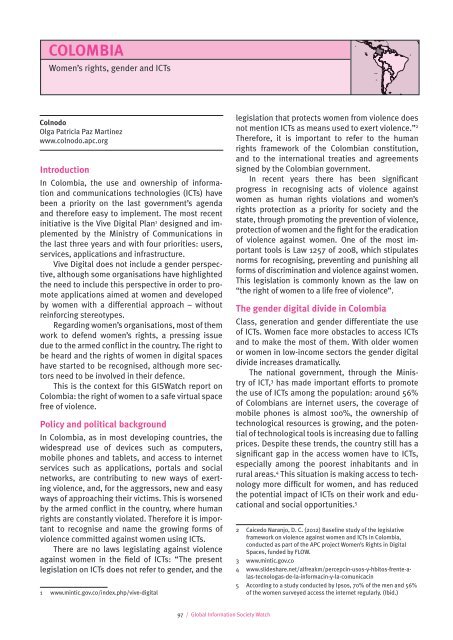gisw13_chapters
gisw13_chapters
gisw13_chapters
Create successful ePaper yourself
Turn your PDF publications into a flip-book with our unique Google optimized e-Paper software.
colombiaWomen’s rights, gender and ICTsColnodoOlga Patricia Paz Martinezwww.colnodo.apc.orgIntroductionIn Colombia, the use and ownership of informationand communications technologies (ICTs) havebeen a priority on the last government’s agendaand therefore easy to implement. The most recentinitiative is the Vive Digital Plan 1 designed and implementedby the Ministry of Communications inthe last three years and with four priorities: users,services, applications and infrastructure.Vive Digital does not include a gender perspective,although some organisations have highlightedthe need to include this perspective in order to promoteapplications aimed at women and developedby women with a differential approach – withoutreinforcing stereotypes.Regarding women’s organisations, most of themwork to defend women’s rights, a pressing issuedue to the armed conflict in the country. The right tobe heard and the rights of women in digital spaceshave started to be recognised, although more sectorsneed to be involved in their defence.This is the context for this GISWatch report onColombia: the right of women to a safe virtual spacefree of violence.Policy and political backgroundIn Colombia, as in most developing countries, thewidespread use of devices such as computers,mobile phones and tablets, and access to internetservices such as applications, portals and socialnetworks, are contributing to new ways of exertingviolence, and, for the aggressors, new and easyways of approaching their victims. This is worsenedby the armed conflict in the country, where humanrights are constantly violated. Therefore it is importantto recognise and name the growing forms ofviolence committed against women using ICTs.There are no laws legislating against violenceagainst women in the field of ICTs: “The presentlegislation on ICTs does not refer to gender, and the1 www.mintic.gov.co/index.php/vive-digitallegislation that protects women from violence doesnot mention ICTs as means used to exert violence.” 2Therefore, it is important to refer to the humanrights framework of the Colombian constitution,and to the international treaties and agreementssigned by the Colombian government.In recent years there has been significantprogress in recognising acts of violence againstwomen as human rights violations and women’srights protection as a priority for society and thestate, through promoting the prevention of violence,protection of women and the fight for the eradicationof violence against women. One of the most importanttools is Law 1257 of 2008, which stipulatesnorms for recognising, preventing and punishing allforms of discrimination and violence against women.This legislation is commonly known as the law on“the right of women to a life free of violence”.The gender digital divide in ColombiaClass, generation and gender differentiate the useof ICTs. Women face more obstacles to access ICTsand to make the most of them. With older womenor women in low-income sectors the gender digitaldivide increases dramatically.The national government, through the Ministryof ICT, 3 has made important efforts to promotethe use of ICTs among the population: around 56%of Colombians are internet users, the coverage ofmobile phones is almost 100%, the ownership oftechnological resources is growing, and the potentialof technological tools is increasing due to fallingprices. Despite these trends, the country still has asignificant gap in the access women have to ICTs,especially among the poorest inhabitants and inrural areas. 4 This situation is making access to technologymore difficult for women, and has reducedthe potential impact of ICTs on their work and educationaland social opportunities. 52 Caicedo Naranjo, D. C. (2012) Baseline study of the legislativeframework on violence against women and ICTs in Colombia,conducted as part of the APC project Women’s Rights in DigitalSpaces, funded by FLOW.3 www.mintic.gov.co4 www.slideshare.net/alfreakm/percepcin-usos-y-hbitos-frente-alas-tecnologas-de-la-informacin-y-la-comunicacin5 According to a study conducted by Ipsos, 70% of the men and 56%of the women surveyed access the internet regularly. (Ibid.)97 / Global Information Society Watch


